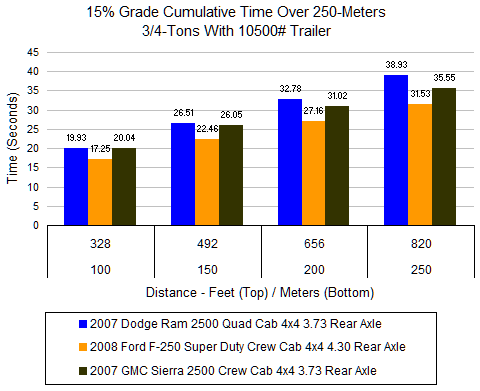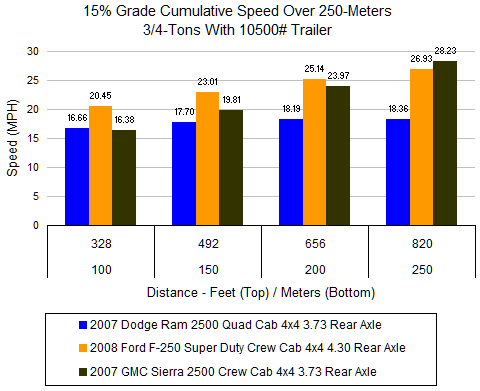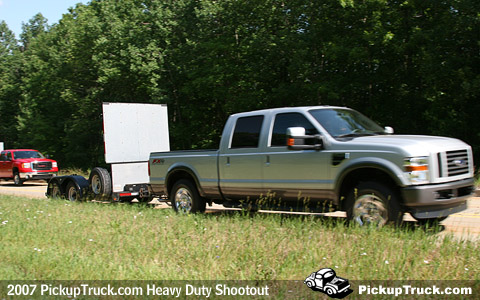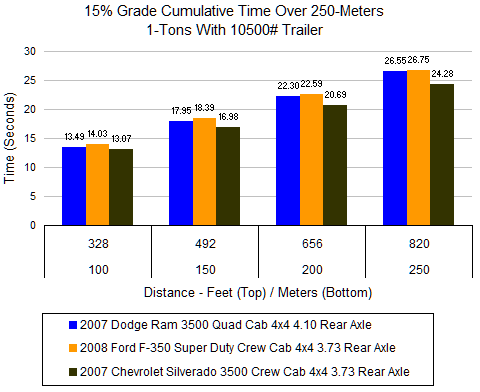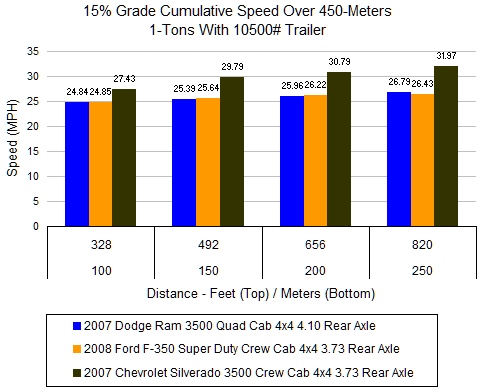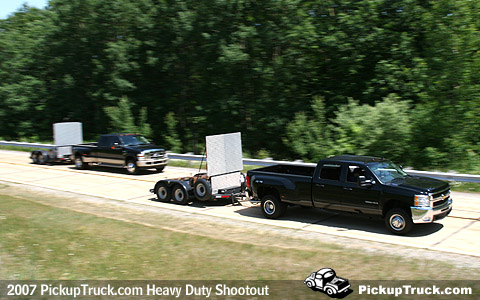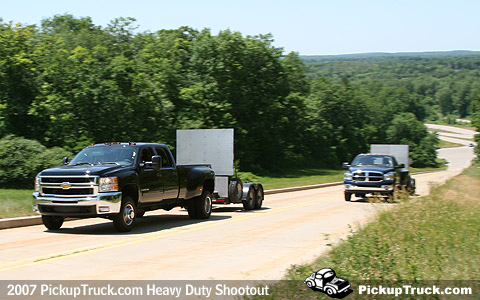Three-Quarter-Ton Gas Pickups - 15% Grade W/10,500# Trailer: The 15% grade was where we separated the men from the boys. Inclinations this steep expose even the slightest powertrain and platform weaknesses. And there was almost no time for a truck to recover and mask any shortcomings in its powertrain during the brief 820-foot run.
NOTE: Due to space and readability considerations, the bar graphs below only show the test results from 100-m (300-feet) to 250-m (820-feet). See the table at the bottom for full test results from 50-m to 250-m. All times and speeds measured are shown cumulative over the run. In the graphs below: the lower a truck's bar is, relative to the other two trucks' bars, in the "Time Over 250-Meters" graph the better it performed. The higher a truck's bar is, relative to the other two trucks' bars, in the "Speed over 250-Meters" graph, the better it performed. The shortest time required to cover the 250-meter distance determined the best performing truck.
Three-Quarter-Ton Gas Pickups 15% Grade Assessment: The V10 powered F-250's timing was even better during the 15% incline than the 7% hill, relative to the Sierra and Ram times in the same tests. The 4.30 rear was a huge help, but the V10's monster torque was also required to get off to a dominant 16.61-mph start in the first 50-m. Ford's gas engine team should be very proud of how this truck performed on such a radical slope. The Sierra also performed ok. But we wonder how much closer or different the results would have been if the old 8.1-liter big block V8 was still available for the GMT900 heavy dutys. But the Ram. Whoa. It fell flat in this contest. In first gear the 5.7-liter HEMI V8 got off to a good start, neck and neck with the 6.0-liter Vortec Max in the GMC, but as soon as the HEMI shifted into that tall 1.67:1 second gear (that we first mentioned during the level 1/4-mile hauling tests) the truck could only lug its way up the rest of the hill. It was a graphic example of how a single mismatch in components caused a giant stumble in performance during this stress test. |
||||||||||||||||||||||||||||||||||||||||||||||||||||||||||||||||||||||||
|
One-Ton Diesel Pickups - 15% Grade w/10,500# Trailer: After witnessing the dramatic results of the 15% contest among the gas trucks, we were even more interested to see what changes or stumbles might await the diesels on this steep hill.
NOTE: Due to space and readability considerations, the bar graphs below only show the test results from 100-m to 250-m. See the table at the bottom for full test results from 50-m to 250-m. All times and speeds measured are shown cumulative over the run. In the graphs below: the lower a truck's bar is, relative to the other two trucks' bars, in the "Time Over 250-Meters" graph the better it performed. The higher a truck's bar is, relative to the other two trucks' bars, in the "Speed over 250-Meters" graph, the better it performed. The shortest time required to cover the 250-meter distance determined the best performing truck.
One-Ton Diesel Pickups 15% Grade Assessment: If we were directing marketing for GM, here's how we'd pitch its diesel motor. D for Duramax. D for dominant. Check out the how fast the Chevy finished the hill climb - more than 5-mph faster and over 2 seconds quicker than either the Ford or Dodge haulers! This time it even beat the Cummins in the first 50-meters. Though the Power Stroke was still slower than the Cummins to the top, the gap between those two engines narrowed substantially on the 15% grade, in favor of the Ford. If the F-350 and Ram 3500 both had 3.73 rear gear ratios, instead of the Ram's 4.10, we think the F-350 almost certainly would have moved into the second spot. But there was an incredibly interesting reason why the performance gap between the F-350 and Ram 3500 seemed to close so much. After two sprints up the hill, the F-350's diesel particulate filter (DPF) went into regeneration mode. The DPF is a new emissions control device required to reduce diesel particulate emissions 10-fold from 2006 model year levels. Regeneration is triggered when the truck senses too much back pressure from the DPF, because of a large amount of trapped particulates. To get rid of the soot, the engine injects metered amounts of diesel fuel into the exhaust stream to incinerate the soot in the filter. On the third run, after regenerating, the F-350 ran the hill up to a full 2-kilometers-per-hour (1.2-miles-per-hour) faster than its first two passes. We were very surprised by the apparent power boost the Power Stroke received from regeneration. It illustrated just how much the new DPFs can restrict airflow through the exhaust system, and the challenge faced by all the OEMs to improve engine performance while complying with new emissions regulations.
Part 3:
[Intro]
[3/4-Ton
7% Grade] [1-Ton
7% Grade] [Diesel
v Gas Comparison 7% Grade] |
||||||||||||||||||||||||||||||||||||||||||||||||||||||||||||||||||||||

